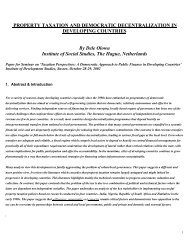View Article - Institute of Development Studies
View Article - Institute of Development Studies
View Article - Institute of Development Studies
Create successful ePaper yourself
Turn your PDF publications into a flip-book with our unique Google optimized e-Paper software.
44b) resource mobilisation - revenue autonomy, the local resource base etc. becomerelevant concerns here; also the issue <strong>of</strong> local capital accumulation and the flight <strong>of</strong> footloosecapital from rural to urban and semi-urban areas for more pr<strong>of</strong>itable investment becomesgermane to our research agenda; although the ‘local’ is not necessarily connected with the‘global’ in a direct and straightforward way, under the influence <strong>of</strong> new global forces,localities witness some visible changes. In West Bengal a major shift is under way fromthe regime <strong>of</strong> land reforms to one <strong>of</strong> land markets and contract farming. All this will havea direct bearing on resource mobilisation under PRI auspices); one may however ask whatincentives the GP will have to use its power <strong>of</strong> revenue raising when transfer from aboveis assured. But given the huge burden <strong>of</strong> debt on both the Central and State governments,it is doubtful how long the fund flow will last. According to one estimate, the debt burden<strong>of</strong> the Cnetral government is in the order <strong>of</strong> Rs. 8000 trillion. Of the total State-level debtburden, West Bengal’s share is high – almost double the average burden. The per capitashare <strong>of</strong> the debt burden in many other States is about Rs.4000 whereas in West Bengal thecorresponding figure is roughly about Rs.9000;c) resource use – autonomy in spending decisions is the key question here. ArePRIs simply implementation agencies for development projects conceived at higher levelsand therefore remain straight-jacketed within the confines <strong>of</strong> ‘tied’ grants or do the actualprocesses <strong>of</strong> budgetary allocations leave some room for flexibility such that in somesituations enterprising PR representatives or local bureaucrats (e.g. BDOs) are able to get‘committed’ funds released for other uses, driven by locally set priorities? The LBs are<strong>of</strong>ten devoid <strong>of</strong> autonomy in determining their spending priorities. The grants are generallytied (i.e., scheme-specific) and hence curb expenditure autonomy <strong>of</strong> PRIs (Jha, 2002).That is to say, the capacity <strong>of</strong> PRIs is limited in this context, as they are primarilyimplementer <strong>of</strong> government programmes and their role is largely in identifying beneficiariesfor poverty alleviation programmes. But interestingly in using schematic funds there issome leeway in somehow getting tied grants untied. 25 Therefore, some room exists forusing schematic budget in an innovative way. It is the careful analysis <strong>of</strong> such divergentbudgetary practices, over and above the study <strong>of</strong> routine allocation <strong>of</strong> funds, which willhopefully illuminate our understanding <strong>of</strong> inter-State and even inter-tier variations in fiscalperformance.Another important element is to contrast citizens’ resource mobilisation for localdevelopment projects – both formal and informal. Interviews with several experts and





